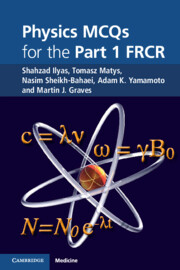Book contents
- Frontmatter
- Contents
- Preface
- Acknowledgements
- 1 Basic physics
- 2 Radiation hazards and protection
- 3 Imaging with X-rays
- 4 Film-screen radiography
- 5 Digital radiography
- 6 Fluoroscopy and mammography
- 7 Nuclear medicine
- 8 Computed tomography
- 9 Imaging with ultrasound
- 10 Magnetic resonance imaging
- Bibliography
- Index
10 - Magnetic resonance imaging
Published online by Cambridge University Press: 05 July 2011
- Frontmatter
- Contents
- Preface
- Acknowledgements
- 1 Basic physics
- 2 Radiation hazards and protection
- 3 Imaging with X-rays
- 4 Film-screen radiography
- 5 Digital radiography
- 6 Fluoroscopy and mammography
- 7 Nuclear medicine
- 8 Computed tomography
- 9 Imaging with ultrasound
- 10 Magnetic resonance imaging
- Bibliography
- Index
Summary
Regarding nuclear magnetic resonance imaging (MRI):
In an external magnetic field, more hydrogen nuclei align with their magnetic moments parallel to the external field than antiparallel
Protons subject to a strong static external magnetic field start to precess in phase
The frequency of precession (Larmor frequency) of protons in a static magnetic field of 1.5 T equals 42.6 MHz
At 1.5 T, the precessional frequency of hydrogen nuclei in fat is 220 Hz lower than that of hydrogen nuclei in water
Apart from hydrogen, other nuclei that can be polarized in an external magnetic field include carbon 12C and oxygen 16O
Which of the following are true about MRI signal formation in biological tissues?
A free induction decay (FID) signal can only occur after a 90° pulse
After a 90° pulse, the longitudinal magnetization recovers at the same rate as the transverse magnetization decays
The rate of the longitudinal magnetization recovery does not depend on the external magnetic field strength
Dephasing of the transverse magnetization is mainly due to spin–lattice relaxation
The FID is not usually considered in clinical MRI
In spin–echo (SE) imaging:
The first radiofrequency pulse in a spin–echo pulse sequence is a 180° pulse
Rephasing of the transverse magnetization is caused by the 180° pulse
[…]
- Type
- Chapter
- Information
- Physics MCQs for the Part 1 FRCR , pp. 126 - 143Publisher: Cambridge University PressPrint publication year: 2011



